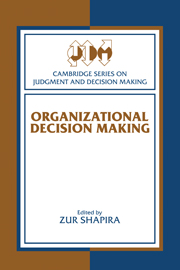Book contents
- Frontmatter
- Contents
- Series preface
- List of contributors
- Editor's preface
- Part I Introduction
- Part II Information processing and attention allocation
- Part III Preference processing
- 6 The social ideologies of power in organizational decisions
- 7 Managerial incentives in organizations: Economic, political, and symbolic perspectives
- 8 Coordination in organizations: A game-theoretic perspective
- Part IV Decision processes
- Part V Alternative approaches
- Name index
- Subject index
6 - The social ideologies of power in organizational decisions
Published online by Cambridge University Press: 06 August 2010
- Frontmatter
- Contents
- Series preface
- List of contributors
- Editor's preface
- Part I Introduction
- Part II Information processing and attention allocation
- Part III Preference processing
- 6 The social ideologies of power in organizational decisions
- 7 Managerial incentives in organizations: Economic, political, and symbolic perspectives
- 8 Coordination in organizations: A game-theoretic perspective
- Part IV Decision processes
- Part V Alternative approaches
- Name index
- Subject index
Summary
There are two kinds of power: the clean and the dirty. The dirty kind is what people usually mean when they talk about politics. It is the power with a bad reputation. It is visible. It engenders outrage. It is the power you see when clashing interests subside, with one party always being disappointed. Dirty power is the kind that gets reported in the newspapers, like the flap reported about the U.S. Commerce Department's veto of a recommendation that Westinghouse receive the Baldridge Award in 1992. Unknown to Westinghouse or the judging panel recommending the company, the Commerce Department conducts its own investigation to determine the suitability of an applicant. In this case, the concern might have been national attention being drawn to the government's handling of nuclear waste (Fuchsberg, 1992).
Here we will not focus on this familiar form of power, since others have done so, and well (e.g., Ferris, Russ, & Fandt, 1990; Pfeffer, 1981). Instead, we will examine the other kind: the clean form of power. This form of power doesn't have a familiar name, although it had been called institutional power in earlier work (Salancik & Pfeffer, 1977). It is the invisible form of power. Here we will argue that this form of power underlies much of the stability observed in the decision making of organizations. It is the reason the powerful retain their positions and the reason discriminations of the past continue becoming discriminations in the present.
- Type
- Chapter
- Information
- Organizational Decision Making , pp. 111 - 132Publisher: Cambridge University PressPrint publication year: 1996
- 6
- Cited by



